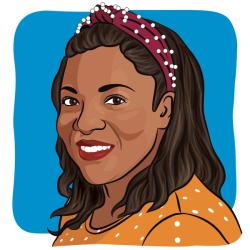- About
- Advertise / Support
- Contact
- CancerNetwork.com
- TargetedOnc.com
- OncLive.com
- OncNursingNews.com
- Terms & Conditions
- Privacy
- Do Not Sell My Information
© 2024 MJH Life Sciences™ and CURE - Oncology & Cancer News for Patients & Caregivers. All rights reserved.
From a Cough to Metastatic Lung Cancer

Janet Freeman-Daily is a writer, speaker, science geek and epatient with metastatic lung cancer. She uses her systems engineering background to translate the experience and science of lung cancer treatment and research into language other patients can understand. She comoderates the Lung Cancer Social Media (#LSCM) Chat on Twitter and blogs at www.grayconnections.wordpress.com.
As a nonsmoker, lung cancer was never on my radar, especially not metastatic lung cancer.
In Seattle, home of Starbucks, everyone drinks coffee: parents, children, athletes, students, artists, friends. If you saw me ordering a split shot grande skinny mocha, I would seem like any other customer. You probably couldn’t tell that I have advanced lung cancer. It certainly came as a surprise to me.
In March 2011, I was healthy, a bit overweight, and exercising regularly. However, I’d had a nagging cough for a few months. To make my husband happy, I mentioned the cough to our doctor. Two months, two rounds of antibiotics, one X-ray, one CT scan, and a bronchoscopy later, I spent a very anxious four days waiting for biopsy results.
When I heard "lung cancer" I could barely believe the diagnosis. I called my sister to tell her the news, poured a big glass of wine, and lost myself in a favorite science fiction movie.
I had never lived with smokers, never worked in a smoking environment, never smoked anything (except a salmon). I knew nothing about lung cancer. The facts I found online were not encouraging--especially the survival rates. As we moved through the various staging procedures, my family and I experienced increasing levels of fear:
- "It's OK, it's just one tumor. VATS surgery will probably take care of it."
- "Well, OK, lymph nodes are involved, but still inside one lung. We can remove the lung, right?" (OhMyGod)
- "There's a lymph node between the lungs, severe inflammation and obstructive pneumonia. Stage 3a. No surgery." This is serious. After my mediastinoscopy, my sister left the hospital convinced I was dying.
I was reassured to hear my oncologist say he considered me curable. I was eager to start aggressive lung cancer treatment. But the universe, it seemed, objected to the treatment plan. The interior of my tumor had died and become colonized by bacteria. Even though we finally found an antibiotic that knocked out the infection, my recovery took weeks. During that time, I developed a clot on my PICC line and required daily self-injected blood thinner. Heaven forbid I should be a boring, vanilla cancer patient! I worried my lung cancer was growing while I waited to start treatment.
I hit bottom a few days after my second bronchoscopy. I awoke at 3 a.m. coughing up a lot of blood, and my pulmonologist told me to go to the emergency room. I was released later that morning, just in time to drive 30 miles to my first radiation treatment. The linear accelerator was down two hours for repairs, but I did eventually get zapped. My husband and I drove to a nearby restaurant for a very late lunch, and came out to find our car had a flat tire. Not a very reassuring start.
The next few months were consumed by my daily appointments. Perhaps the toughest part was telling my autistic adopted son that he might lose another mother to cancer. My bucket list became laser-focused on helping him prepare to live on his own. Despite fatigue and severe esophagitis, I was able to attend my niece's wedding a month later. You haven't lived until you've had Ahi tuna encrusted in coffee beans -- pureed for a liquid diet. At one point I was taking ten different meds to control pain and side effects. My butt was dragging, my blood values tanked after one full dose of chemo, and I broke out in hives during my second red cell transfusion. But gradually, I started feeling better.
It all seemed worthwhile when my first post-treatment CT scan showed my lymph nodes had resolved and the primary tumor had shrunk about 90%. I wanted that tumor OUT, if possible. I had 15 appointments in 16 days to determine if the surgery would be an acceptable risk--we only had a short window in which to do surgery before radiation changes would make it too risky. Juggling that schedule generated a lot of additional stress -- my family's life revolved completely around my cancer. I wished my medical center had a Lung Cancer Navigator to coordinate all the appointments between seven different providers at four different facilities, communicate results, explain terms and options in more detail, and ensure timely follow-up.
The last procedure, a PET scan, showed a hot spot on my collarbone. My pulmonologist (the lead of my lung cancer team) quickly arranged an MRI scan for the next morning, and a surgical open biopsy on the following day. To find the tiny suspicious lymph node, a nurse injected me about an hour in advance with the same tracer used for a PET scan (radioactive glucose), and the surgeon used a Geiger counter.
The Geiger counter found not one, but two nodes near my collarbone. Both contained the same cancer as my lung tumor. One hard, white node was solid cancer.
I had just become a metastatic lung cancer patient.
Image credits:
© Dolgachov | Dreamstime.com - Woman With Hands On Ears Photo
Related Content:



